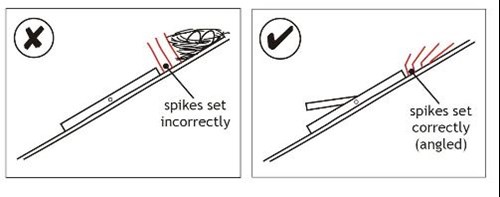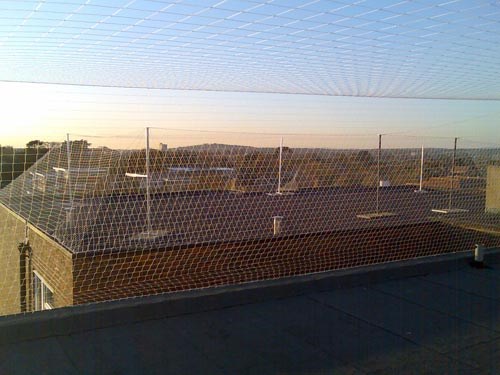Protecting your Property
In order to minimise the negative impact of gulls on your property it is important to establish exactly what causes the problem you are most concerned about and secondly appreciate how gulls will react to any action you take:
Noise, nesting materials clogging up storm drainage and damage to buildings
Breeding pairs court in April and commence nest building from early May onward. In towns the nests tend to be constructed from straw, grass, twigs, paper and any other material the gull can conveniently use. These nests can be large and if they are made of material accumulated over several years, they can become quite heavy. If a breeding site is established, then the gulls will return year after year. Gulls are social creatures and once roof nesting gets a hold, other gulls will start to move in to an area and nest on adjacent buildings, until their numbers build up sufficiently that a colony is established.
In urban areas gulls prefer flat roofs with a little substrate (gravel etc) to nest. The simple nest can be built in a matter of hours. On a modern building, nests will tend to be built behind a parapet wall or where there is protection from the elements often occupying difficult to access locations between chimney pots and tucked away on ledges.
It is important to clear old nests away at the end of the breeding season and it provides an opportunity to repair any damage whilst you are accessing the roof. Your insurance may require you to undertake such regular maintenance work. A little forethought therefore in ‘designing-out’ obvious nesting sites or installing preventative measures can pay significant dividends in later years. The adult courting birds will also seek rooftop vantage points to call. Reducing the ability for the birds to use such vantage points or settle along roof lines will help.
Gull attacks and aggression, and droppings/mess
Eggs are laid from early May onward with 2 or 3 being the usual number. The eggs take about four weeks to hatch, which means that the first chicks are seen around the beginning of June. This is when the adult birds are their most aggressive both in terms of ‘dive bombing’ and ‘excreting droppings’ on threats such as people or pets. The chicks grow quickly and are quite active, which means that they often fall from their nests. In towns this often means that they are unable to return to their nests. Small chicks will die if they are not returned, but the larger chicks will be protected by their parents and fed on the ground. Increased aggression may be experienced as a result with parents trying to defend the fallen chick. The chicks generally fledge in August and then take about three years to reach maturity when they in turn will start to breed. The life expectancy for gulls can be up to 20 years.
‘Designing-out’ obvious nesting sites or installing preventative measures can pay significant dividends in later years.
If dive bombing and mess are your concern, designing in covered walkways, car ports or vegetation to disrupt the flight path will reduce the ability for the birds to cause you concern. Hawk flying and birdscarers does not help with concerns of bird fouling. They will cause the birds to take flight suddenly when the birds automatically excrete which then exacerbates the problem.
Gull Control Options
There are a number of simple techniques that can be employed to make your building less attractive to gulls. Broadly these can be split into two distinct categories. The first is to ‘design-out’ nesting sites in the first place. The second concerns attaching other structures to deter the birds. The latter can be retro-fitted, but the former is probably more effective.
Flat roofs are the favourite nesting sites for these birds. Modern office and commercial buildings provide ideal sites. Without suggesting that the whole design process should focus on gulls, a few points below should be kept in mind.
Nests require something to grip onto. If the roof is on a slope then a smooth surface will be less attractive. Generally, on a smooth roof such as a typical commercial ‘crinkly tin’ building, a roof plane of more than 25 degrees will tend to be too steep. Any less than this and gulls will be attracted to it. Small interruptions in the roof plane on any building can provide enough purchase for a gull nest. This may have to be included in your design to accommodate a stairwell or some plant housing. If it can’t be designed-out, make sure a nest cannot be easily built by using spikes or wires (see diagram).

Modern flat-roofed office and residential buildings provide ideal nesting areas. Designing-out nesting sites in such buildings may well be impractical. Netting or other protective measures may not be wanted for aesthetic reasons or because of the cost of installation and maintenance. If this is the case then ease of access can make a significant difference to any owner/occupiers ability to deal with the birds in a cost effective way. Access to all the roof area without the need for climbing boards or ladders can make the maintenance of the roof far more straightforward. If gulls do take up residence, blocked gullies, vents and similar features will become a problem. Easy roof access can help deal with this.If the eggs are to be treated in some way, e.g. through WRS chargeable egg replacement service, easy access is fundamental. If access is not straightforward and safe, the council is unable to take action. The harder it is to get to nests, the more expensive it will be to treat them. For residential buildings, roof gardens are seen as preferable. They allow easy access and, if used frequently, they will be a deterrent in themselves to a colony establishing on a roof. Roof gardens have other benefits, such as attenuating rainwater run off and insulating buildings, though care must be taken with over-looking other buildings and in historic areas.
For flat and pitched roofs, if rain water is harvested, precautions should be taken to prevent contamination with guano (bird faeces) and other debris.
Spikes and wires:

These are typically a series of upturned spikes that deter gulls from roosting or, in certain circumstances, from nesting. Spikes can be effective on ledges where, if enough of them are used, they will deter the birds. They are generally ineffectual if placed around parapet walls or installed at low densities. In certain circumstances, spikes can be visually intrusive and should be used with great care in conservation areas and on listed buildings. They are most useful when restricting access to certain localised sites typically inhabited by Herring gulls. For example they can be effective on sites around chimney stacks. Again, if this is done properly at the outset, it can prevent problems later on. There are different ways of using wires. One of the simplest methods is to stretch wires along the ridge of pitched-roof buildings. These will not deter nesting birds, but will prevent roosting. Although generally quiet when roosting, the birds will deposit a large amount of droppings. These look unsightly, will be expensive to clean and will hasten the deterioration of the roof fabric. Wires can be stretched across a flat roof. These are aligned in parallel rows at a distance that will prevent a gull from landing. They have the advantage that other birds do not get snagged in them, and they can be less visually intrusive than nets.
Netting:

Netting is the most common form of prevention and can be retrofitted to most buildings. However, it can look ugly and careful siting and design will be needed to minimise its appearance. Netting comes in a range of colours so it is important that an appropriate shade is chosen. Where the netting will be close-fitting to the roof it may be more acceptable to choose a netting colour to match the roof materials. Where the netting is to be located above the roof plane, so that sky is visible between the roof and the netting (when viewed from the street), a transparent or neutral colour would be more appropriate. Vivid or fluorescent colours should be avoided as they stand out unnecessarily.
Another important consideration when using netting as a solution is the visual impact to wider views across the area. Of particular concern are views of historic monuments. These may be views from the street or from other buildings such as offices or multistory car parks. Locating the netting further back on the roof and using a combination of methods such as wires or spikes, will help to minimise the visual impact from the street.
These procedures are not necessarily foolproof and birds can make nests on top of them. Remember, gulls and other birds may become snagged in the netting. Not only does this cause unnecessary distress and suffering for the birds, but can create unfavourable publicity for the building owner. As a guide, a mesh size of 75mm is generally considered most appropriate for gulls.
The fitting of netting, spikes or any other structure to listed buildings or those buildings within conservation areas should be undertaken with special care and sensitivity. In most cases Listed Building Consent or planning permission will be required. Before undertaking any works please contact your local Planning Office.
Action to protect public health and safety which involves the disturbance, destruction or removal of Herring or Lesser Black-backed gulls eggs or nest will require an Individual Licence from Natural England.
Customers should contact WRS if they require assistance to register their interest for egg replacement or advice.
Egg replacement is currently focused on Worcester City centre and specific locations around the periphery where there have been issues of concern. If you own or are tenant of a city property which traditionally has nesting gulls and have been negatively impacted by the gulls, it may be possible to include your property in the treatment programme. If you wish to be considered for inclusion in the treatment programme please complete the existing programme form.
If you own or tenant of a large roof in city, with regular nesting upon which you are considering undertaking maintenance or cosmetic work, it may be possible to work with you in deterring gulls from using your building with a red roof trial. If you wish to be considered for inclusion in this complete the trial programme form.
All manner of scaring techniques have been tried in many cities across the country. Many appear to be a waste of money, though more innovative systems are currently being developed. The following have proved to be less than helpful.
- Plastic Eagles & Owls
- Scaring devices
- Distress calls
- Other noise based scaring devices
- Wind Driven scaring devices
For more information follow the link to our Gull Control work in Worcester City page.